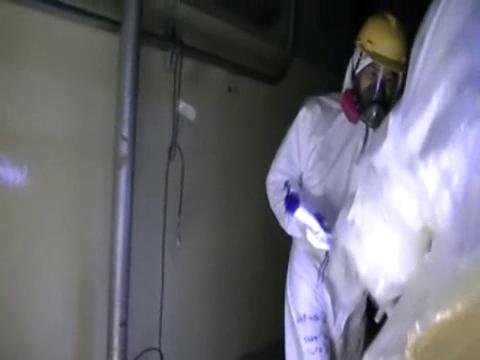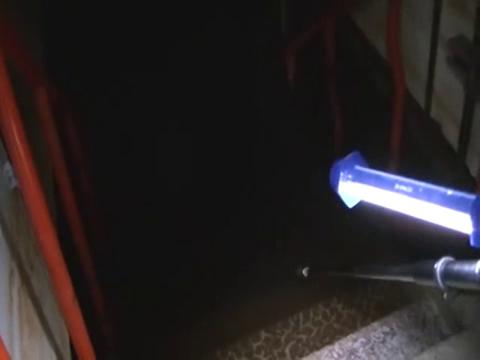It looks like you're using an Ad Blocker.
Please white-list or disable AboveTopSecret.com in your ad-blocking tool.
Thank you.
Some features of ATS will be disabled while you continue to use an ad-blocker.
Fukushima Clean-up Progress. Inside the Reactors 3/15/2012. Thought it would be better than this.
page: 13
share:
enformable.com...
Woah, things here are progressing VERY slowly. If I can even call it progressing. After a year, this is the best footage of inside reactors 2 &3???


I would have thought all that water would have been pumped out by now?
Plus Reactor 4:
fukushima-diary.com...
And then there is the Fukushima Ocean Impact Map
www.asrltd.com...
fukushima-diary.com...
Woah, things here are progressing VERY slowly. If I can even call it progressing. After a year, this is the best footage of inside reactors 2 &3???
On Wednesday TEPCO sent 6 workers into Fukushima Daiichi Units 2 and 3 to inspect the areas around the suppression chamber for the first time. Pipes littered the ground, and workers were careful to measure the radiation levels prior to entering a new area inside the wrecked building. The lower levels were confirmed to still be flooded with contaminated radioactive water, which is having a visible effect on the metal stairs and railing.


I would have thought all that water would have been pumped out by now?
Plus Reactor 4:
fukushima-diary.com...
NHK reported the degree of clearness was 5m, but all the other important information,such as the radiation level, temperature, nuclides, the state of the pool were not reported.
And then there is the Fukushima Ocean Impact Map
www.asrltd.com...
fukushima-diary.com...
edit on 15-3-2012 by UFO1414 because: (no reason given)
Compared to Chernobyl, the Fukushima plant clean up seems to be doing well.
The video in the OP is only a prediction based on mathematical models. Not an actual map of the plume.
I wonder if the moby-duck scenario could be of help here...
en.wikipedia.org...
The video in the OP is only a prediction based on mathematical models. Not an actual map of the plume.
I wonder if the moby-duck scenario could be of help here...
en.wikipedia.org...
Originally posted by OccamAssassin
Compared to Chernobyl, the Fukushima plant clean up seems to be doing well.
The video in the OP is only a prediction based on mathematical models. Not an actual map of the plume.
I wonder if the moby-duck scenario could be of help here...
en.wikipedia.org...
I hope you're right but you contridict your own post. The "Moby Ducks" ended up on beaches all over the planet.
Moby-Duck: The True Story of 28,800 Bath Toys Lost at Sea and of the Beachcombers, Oceanographers, Environmentalists, and Fools, Including the Author, Who Went in Search of Them is a book by Donovan Hohn concerning 28,800 plastic ducks and other toys, known as the Friendly Floatees, which were washed overboard from a container ship in the Pacific Ocean on 10 January 1992 and have subsequently been found on beaches around the world and used by oceanographers including Curtis Ebbesmeyer to trace ocean currents.
The Fukushima radiation ocean currents are in their early progess.
reply to post by UFO1414
How did I contradict my own post?
Compared to Chernobyl......The clean up does indeed seem to be going well.
The video is a mathematical prediction not fact.
The Moby-Ducks do in fact show a dispersal model that could be used to help plot the plumes spread - due to ocean currents and wind.
As to the ducks turning up in beaches all over the world.....Did you really think that the radioactive plume would stay in the oceans? Of course it will dissipate with time as it slowly makes its way around the worlds oceans. Eventually it will either settle on the sea-bed or it will make landfall. It may also pay to note that the ducks can only indicate pathways the radiation may take.....The magnitude of the radioactivity cannot be modelled by the ducks.....That is something that has to be tested on a site by site basis.
It does not change the fact that Fukushima clean up APPEARS to be going well.
I did not say it was perfect.
I just said that it appears to be going well.
I hope you're right but you contridict your own post. The "Moby Ducks" ended up on beaches all over the planet.
How did I contradict my own post?
Compared to Chernobyl......The clean up does indeed seem to be going well.
The video is a mathematical prediction not fact.
The Moby-Ducks do in fact show a dispersal model that could be used to help plot the plumes spread - due to ocean currents and wind.
As to the ducks turning up in beaches all over the world.....Did you really think that the radioactive plume would stay in the oceans? Of course it will dissipate with time as it slowly makes its way around the worlds oceans. Eventually it will either settle on the sea-bed or it will make landfall. It may also pay to note that the ducks can only indicate pathways the radiation may take.....The magnitude of the radioactivity cannot be modelled by the ducks.....That is something that has to be tested on a site by site basis.
It does not change the fact that Fukushima clean up APPEARS to be going well.
I did not say it was perfect.
I just said that it appears to be going well.
Originally posted by OccamAssassin
Compared to Chernobyl, the Fukushima plant clean up seems to be doing well.
Ping Pong (Japanese Agreement)
I expected much more internal Damage after the first Reports and i am more than
happy that my worst Imagination just is an Imagination and not the Truths!
Don't compare Fukushima to Chernobyl
Again, the casualty figures tell their own story. Severe potential hazards did exist on the reactor sites because of high levels of radiation, but health controls were mainly effective.
There were no deaths attributable to radiation. Two workers received burns from beta radiation. They were discharged from hospital after two days. Two workers incurred high internal radiation exposure from inhaling iodine-131, which gives them a significant risk of developing thyroid cancer.
Doses incurred by about 100 other workers have been high enough to cause a small risk of developing cancer after 20 or more years. But the risk is very small indeed. About 25 per cent of the population dies from cancer whether accidentally exposed to radiation or not. This rate might be increased by an additional one or two per cent among the exposed workers.
What is more, exposures to radiation were nowhere near high enough to cause acute radiation sickness. Importantly, there have been no radiation injuries to children or to other members of the public. The INES was intended to aid public understanding of nuclear safety. In fact, it has caused more confusion. It has also probably added to the mental anguish of the Japanese people.
The accident at Fukushima Daiichi was moved to the top of the scale a month after the tsunami for technical reasons, when the estimate of radioactive material released exceeded the International Atomic Energy Agency's criterion for level 7. However, the amount of iodine-131 escaping from all the reactors at Fukushima Daiichi was less than 10 per cent of the amount released at Chernobyl, and the release of caesium-137, the next most important fission product, was less than 15 per cent of the Chernobyl total.
www.newscientist.com...
new topics
-
Anti-Government Protest in Serbia
Social Issues and Civil Unrest: 1 hours ago -
The Effects of Electric Fields and Plasma on Plant Growth
Science & Technology: 2 hours ago -
The Daily Mail trying to imply “it’s aliens”
Dissecting Disinformation: 9 hours ago -
Swarms of tiny 'ant-like' robots lift heavy objects and navigate obstacles
Science & Technology: 11 hours ago
top topics
-
The Carpet Coating that Attacked the Environment
Medical Issues & Conspiracies: 16 hours ago, 15 flags -
NYPD Chief Jeffrey Maddrey Resigns - Forced Officers to Give Sex for Overtime Pay and Favors.
Posse Comitatus: 12 hours ago, 9 flags -
Microplastics in your drinks
Medical Issues & Conspiracies: 17 hours ago, 5 flags -
Swarms of tiny 'ant-like' robots lift heavy objects and navigate obstacles
Science & Technology: 11 hours ago, 5 flags -
The Daily Mail trying to imply “it’s aliens”
Dissecting Disinformation: 9 hours ago, 4 flags -
The Effects of Electric Fields and Plasma on Plant Growth
Science & Technology: 2 hours ago, 4 flags -
Anti-Government Protest in Serbia
Social Issues and Civil Unrest: 1 hours ago, 3 flags
3
